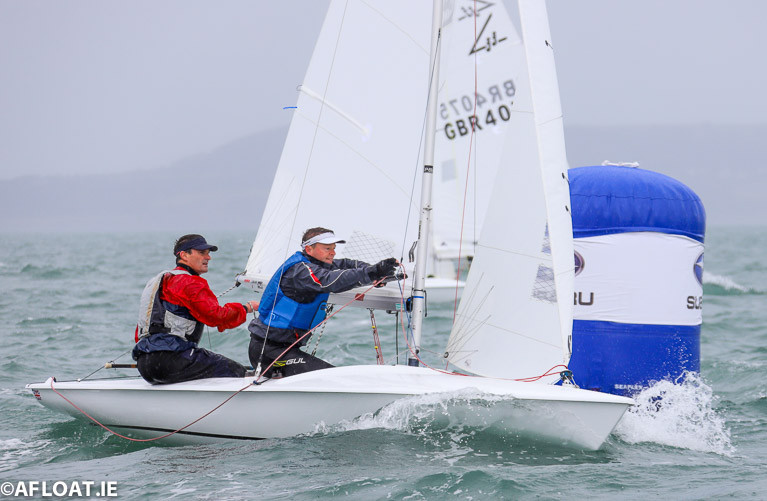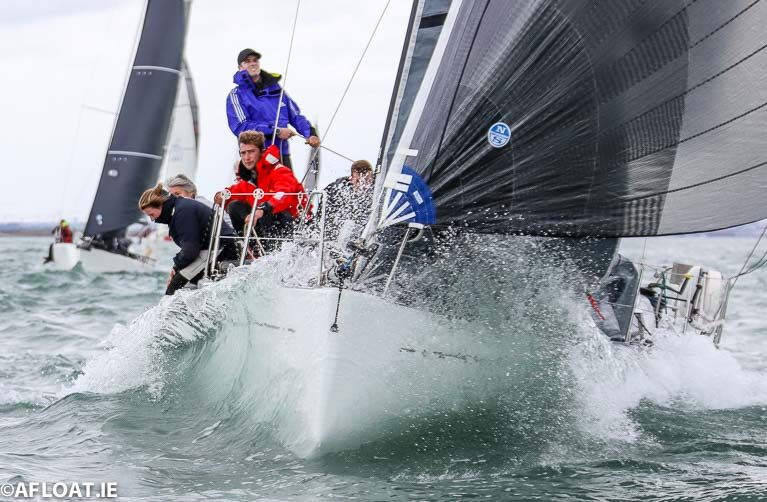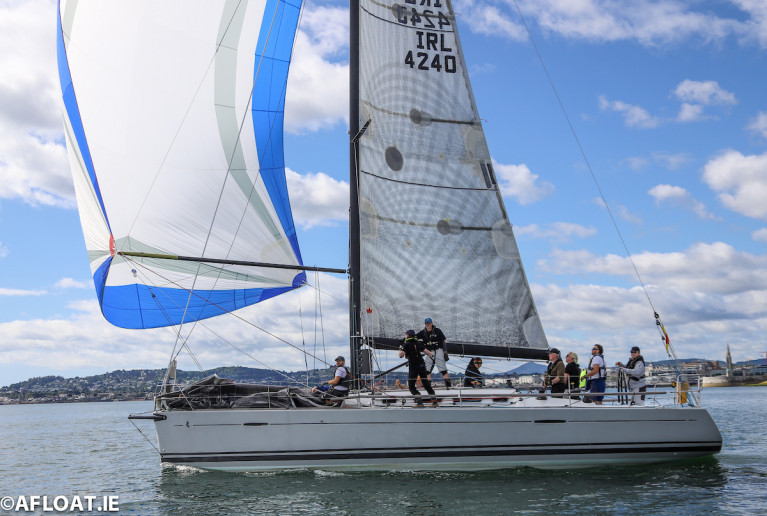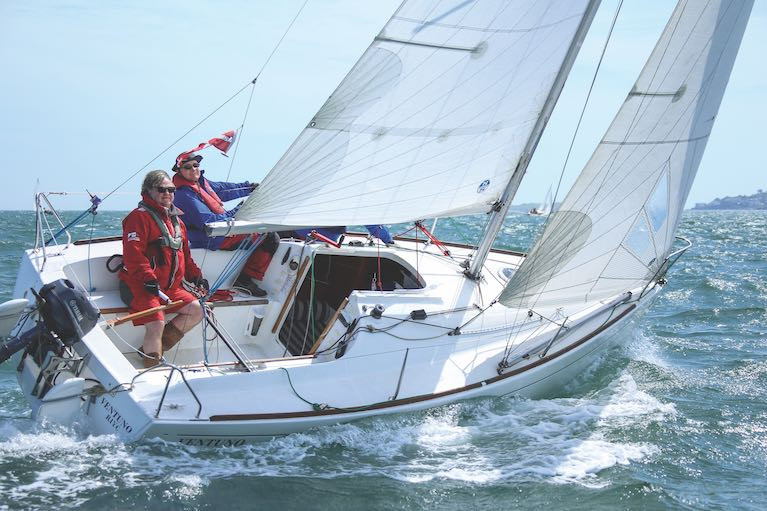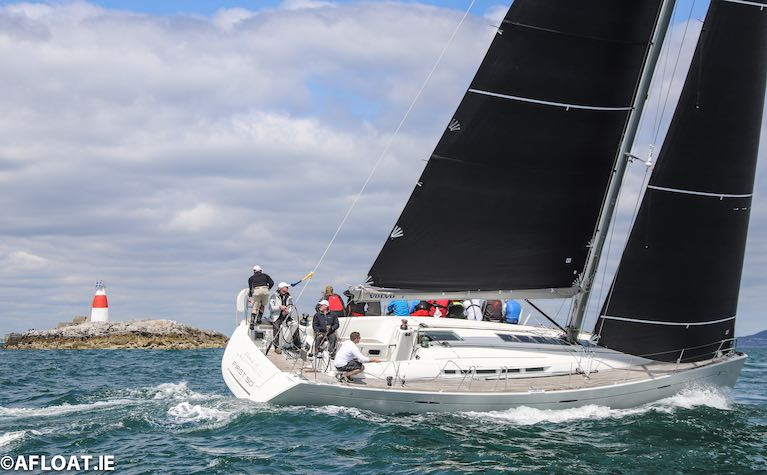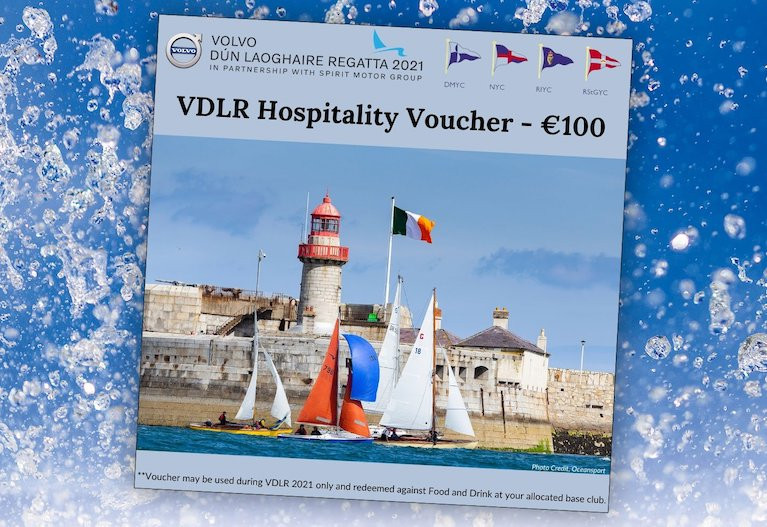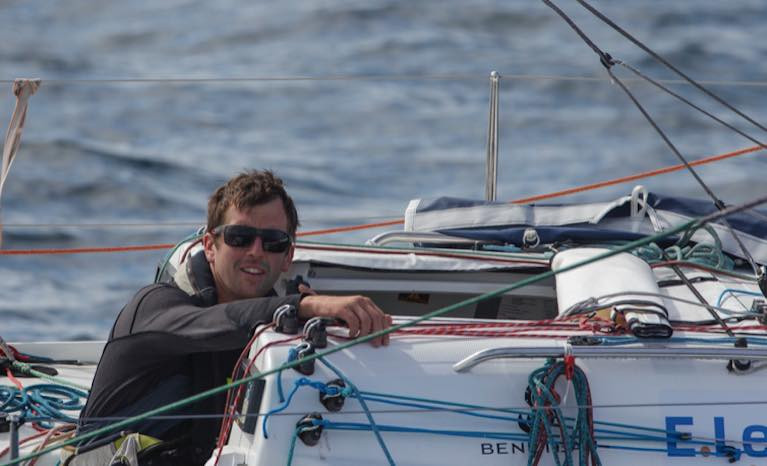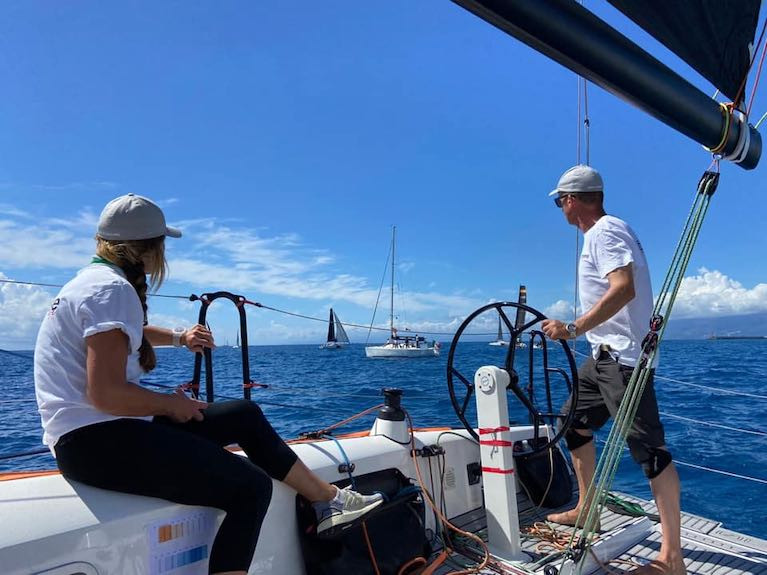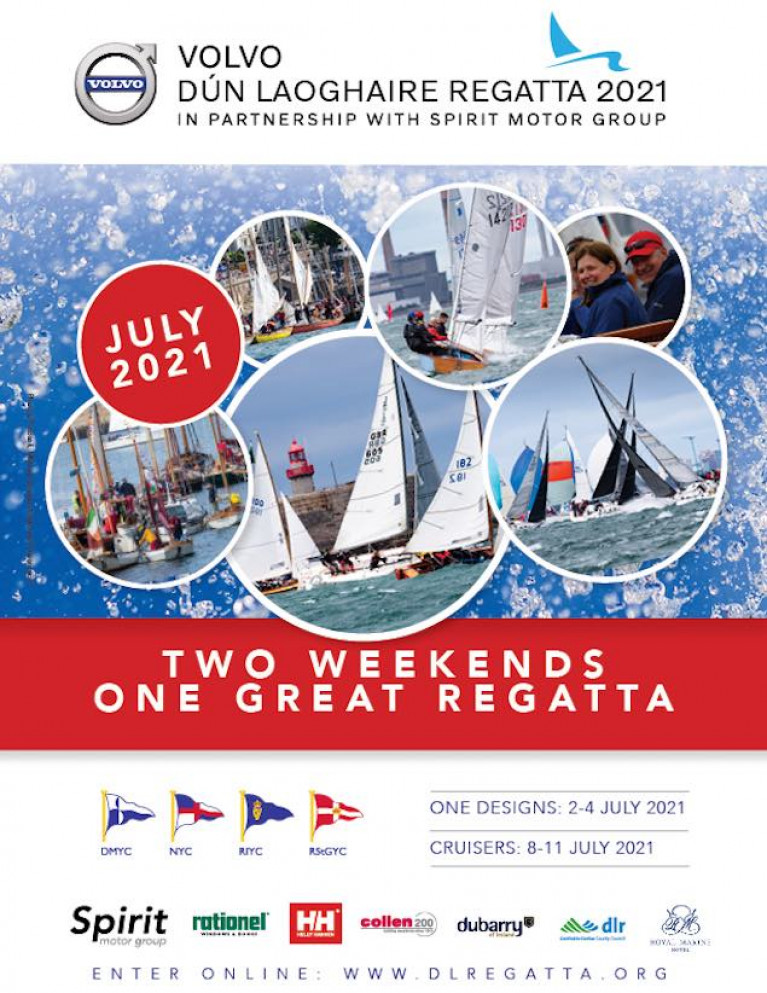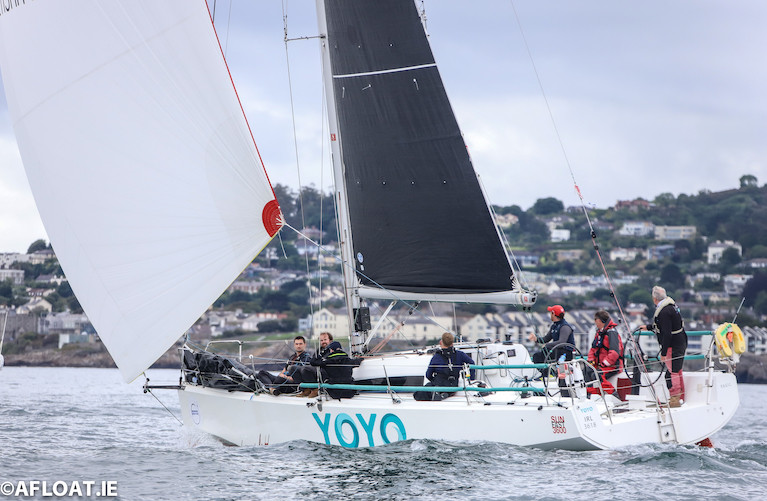Displaying items by tag: Volvo Dun Laoghaire Regatta
Dun Laoghaire's buoyant Flying Fifteen class is getting behind the new format Volvo Dun Laoghaire Regatta 2021 One Design event scheduled for July
With two boats already entered five months before the event, Class Captain Neil Colin of the DMYC is encouraging the Bay's Flying Fifteen sailors and those in other fleets around the country to put the Dun Laoghaire Harbour event in the diary.
As regular Afloat readers will know, in order to facilitate social distancing and be Covid-19 compliant, a new regatta format will comprise a One Design Championship (2nd – 4th July 2021) specifically tailored for sailors in the one-design keelboat and dinghy classes.
Preparations are off to a flying start with nine of the expected 22 racing classes already declaring regional or national championships to be held as part of the biennial sailing festival.
The Flying Fifteens have two entries so far, Neil Colin's own FFuzzy from the Dún Laoghaire Motor Yacht Club and Niall Meagher's Ffantastic Mr Ffox from the National Yacht Club.
Traditionally, the FFers are big supporters of the Dun Laoghaire Regatta with a fleet of 24 boats mustered for the 2019 event and NYC duo David Gorman and Chris Doorly won the overall prize for the best one-design performance of the event.
Royal Cork Rocket Ship 'Nieulargo' Adds Extra Spice to Volvo Dun Laoghaire Regatta Offshore Fleet
Royal Cork Yacht Club's inaugural Fastnet 450 Race winner Nieulargo is among the latest entries into July's Volvo Dun Laoghaire Regatta.
The Muphy family's potent Grand Soleil 40 is now entered into two key Dublin offshore sailing fixtures. The first being June's 280-mile Volvo Dun Laoghaire-Dingle race.
Entry into July's VDLR Regatta means the top-performing south coast cruiser will be making a second trip to the East Coast a month later for the July offshore, a key Irish clash of the season.
As regular Afloat readers will recall, in 2019, the IRC offshore class totalled 28-boats and 2021 is shaping up to be the same healthy number again with eight boats already signed up five months before the first gun.
It means more pressure for defending champion Seamus Fitzpatrick's First 50, Mermaid. The Royal Irish Yacht Club skipper beat the Welsh J109 Mojito, an ISORA champion, for the VDLR title but this year, as Afloat reported previously, the competition looks even tighter with the arrival, among others, of the Ker 40, Arabella into the Dublin Bay scene.
As well as Fastnet 450 Race success, the 2018 RCYC Boat of the Year also took Kinsale Yacht Club's own Fastnet Race title last year, making 2020 one of the most successful SCORA years for the Murphy clan.
VDLR Offshore fleet at January 15th
- Arabella, Ker 40, Royal Irish Yacht Club, Niall Dowling
- Jackknife, J125, Pwllheli Sailing Club, Andrew Hall Sam Hall
- Mermaid IV, Beneteau First 50, Royal Irish Yacht Club, Seamus FitzPatrick
- Black Velvet, Beneteau First 34.7, Royal Irish Yacht Club, Leslie and Ailbhe Parnell
- Lively Lady, Beneteau First 44.7, Royal Irish Yacht Club Rodney & Keith Martin
- D-TOX, X-35, Royal Irish Yacht Club, Patrick McSwiney and Kyran McStay
- Nieulargo Grand Soleil 40 B&C, Royal Cork Yacht Club, Denis & Annamarie Murphy
- WOW XP44 IRL, Royal Irish Yacht Club, George Sisk
- (Double Handed), Silver Shamrock, Half Tonner, Howth Yacht Club, Conor Fogerty
UK & NI Visitors Make Early Entry for Volvo Dun Laoghaire Regatta
230 visiting boats from a fleet of nearly 500 made up nearly half the 2019 Volvo Dun Laoghaire Regatta fleet and this year organisers are reporting strong visitor interest again for 2021’s COVID-formatted event on Dublin Bay.
Interest is coming both from the one design and IRC divisions, six months ahead of the first gun.
The first 2021 entry was received from Northern Ireland, Jay Colville’s First 40, Forty Licks.
Colville, a regular visitor to the Bay, was a runner up in 2019’s Class Zero of the ICRA National Championships also held on Dublin Bay. The Royal Ulster YC and East Down YC entry performs well across the wind range and also finished second at VDLR 2019.
 IRC Cruiser Racing at VDLR 2019 Regatta. In 2021 an Open Cruiser Championship (8th – 11th July 2021) will cater for the full range of Cruiser Handicap classes.
IRC Cruiser Racing at VDLR 2019 Regatta. In 2021 an Open Cruiser Championship (8th – 11th July 2021) will cater for the full range of Cruiser Handicap classes.
Confirmed from across the Irish Sea are IRC visitors, Ruth Adams Charisma 22, ‘HRT’ from West Lancashire Yacht Club and Jonathan Fawcett’s She 31 ‘She Too’ from Wales.
As Afloat reported earlier, VDLR’s offshore class will also have some UK interest with the arrival of the Cowes-based Fast 40, Arabella, sailing under the burgee of the Royal Irish Yacht Club.
Although the 230 yachts from outside the bay area took away only 11 trophies in 2019 (up from seven in 2017), the bulk of the Dun Laoghaire Regatta silverware stayed in Dublin. Such early UK entries this time however, might be an indication of more international interest in the regatta and a bigger raid on the Irish prizes in 2021?
New format regatta for 2021
The Volvo Dun Laoghaire Regatta is a great festival of sailing across the waterfront and Dun Laoghaire town as four sailing clubs come together for the biennial event; Dun Laoghaire Motor Yacht Club, Royal Irish Yacht Club, Royal St. George Yacht Club and National Yacht Club.
The 2019 Volvo Dun Laoghaire event was hailed an enormous success both afloat and ashore for a combined fleet of 498 boats in over 34 classes, the biggest on the Irish Sea. Over 290 races on five different courses were staged over four days.
For 2021, in order to facilitate social distancing and be Covid-19 compliant, a new regatta format will comprise a One Design Championship (2nd – 4th July 2021) specifically tailored for sailors in the one-design keelboat and dinghy classes. This to be followed by an Open Cruiser Championship (8th – 11th July 2021) catering for the full range of Cruiser Handicap classes.
Strong early VDLR entry
In liaising with classes, organisers estimate entry numbers are 'very good' and 'on a par with 2019', so it looks like both VDLR weekends will have a strong entry by the close of the early bird entry discount at the end March.
Early One Design Class Interest in July's New Format Volvo Dun Laoghaire Regatta is Strong
A positive 25 one design entries received so far into ten divisions of Volvo Dun Laoghaire Regatta 2021 has been welcomed by organisers as the combined Dun Laoghaire clubs regatta rolls out its new COVID-compliant format event that splits the regatta between two weekends next July.
The early entries received seven months before the first gun are a sign of the regatta’s importance across the Irish Sea with entries already in from across Ireland and Northern Ireland and the UK.
Beneteau 31.7s
Royal Ulster Yacht Club’s John Minnis and crew will travel from Belfast Lough again in Final Call for the Beneteau 3.17 national championships that is being staged as part of the Regatta running from 2 to 4th July. Minnis was runner-up at the 2019 VDLR event.
The 31.7s are just one of nine class championships being held as part of the regatta.
 The Dublin Bay-based Beneteau 31.7 Levante. The class will race for national championships honours as part of VDLR 2021
The Dublin Bay-based Beneteau 31.7 Levante. The class will race for national championships honours as part of VDLR 2021
Dragon East Coasts
The Dragon’s will race for east coast honours and one of the first entries in is Kinsale’s Tenacious skippered by Anthony O’Neill. The Dragon helm is in charge of the West Cork club’s Sovereign’s Cup regatta that will be held the week before the Dun Laoghaire event.
 GP14s will race for Leinster honours on Dublin Bay in July
GP14s will race for Leinster honours on Dublin Bay in July
GP14 Leinsters
Curly Morris, the President of the International GP14 Class, based at East Antrim Boat Club will contest the GP14 Leinster Championships as part of Dun Laoghaire. The dinghy class was one of the first to sign up for the new format event. A fleet of over 20 is expected.
Sigma 33s
Sigma 33 campaigner David Marchant is coming from Waterford Harbour to join the Dublin Bay fleet that usually attracts strong Scottish interest.
 Sigma 33 racing at VDLR 2019
Sigma 33 racing at VDLR 2019
The Volvo Dun Laoghaire Regatta is a great festival of sailing across the waterfront and Dun Laoghaire town as four sailing clubs come together for the biennial event; Dun Laoghaire Motor Yacht Club, Royal Irish Yacht Club, Royal St. George Yacht Club and National Yacht Club.
The 2019 Volvo Dun Laoghaire event was hailed an enormous success both afloat and ashore for a combined fleet of 498 boats in over 34 classes, the biggest on the Irish Sea. Over 290 races on five different courses were staged over four days.
For 2021, in order to facilitate social distancing and be Covid-19 compliant, a new regatta format will comprise the One Design Championship specifically tailored for sailors in the one-design keelboat and dinghy classes. This to be followed by an Open Cruiser Championship (8th – 11th July 2021) catering for the full range of Cruiser Handicap classes.
Strong early VDLR 2021 entry
As Afloat reported previously, in liaising with classes, organisers estimate entry numbers are 'very good' and 'on a par with 2019', so it looks like both VDLR weekends will have a strong entry by the close of the early bird entry discount at the end March.
Royal Irish Volvo Dun Laoghaire Regatta Offshore Champion 'Mermaid' To Defend Title
The defending Volvo Dun Laoghaire Regatta offshore champion is among the first six entries into that division for July’s regatta, a class that looks set to become one of the biggest fleets of the biennial event again.
As regular Afloat readers will recall, Seamus Fitzpatrick's victory in the First 50, Mermaid came in the final races of the 28-boat IRC offshore class in 2019 when the Royal Irish Yacht Club skipper beat the Welsh J109 Mojito, an ISORA champion, for the VDLR title.
Niall Dowling’s Ker 40 Arabella joins the VDLR offshore fleet
This July, Fitzpatrick can expect more competition in the form of club-mate Niall Dowling’s Ker 40 Arabella that is joining the VDLR offshore fray for the first time. London based Dowling took both line honours and the overall win in Wicklow’s Round Ireland Race in 2018 with the bigger Ker 43 Baraka GP and is set to be back on Irish waters next July 8.
 Ker 40 Arabella (ex-Pace) racing on her home waters of the Solent in the UK's FAST 40 race circuit. Photo: RORC
Ker 40 Arabella (ex-Pace) racing on her home waters of the Solent in the UK's FAST 40 race circuit. Photo: RORC
Royal Irish Beneteau Entries
Three different Beneteau models are already entered for VDLR’s offshore class that, as predicted by Afloat, looks likely to be the type of racing most appropriate in 2021. As well as the Royal Irish champion First 50, other RIYC Beneteau’s are Leslie Parnell’s Beneteau First 34.7 and Keith and Rodney Martin’s Beneteau First 44.7, Lively Lady.
J125 Jackknife returns
 Andrew Hall's J125 Jackknife competing in the 2019 VDLR event Photo: Afloat
Andrew Hall's J125 Jackknife competing in the 2019 VDLR event Photo: Afloat
Another strong offshore entry returning to Dun Laoghaire Harbour is Andrew Hall's J125 Pwhelli-based Jackknife. This regular Irish visitor only narrowly missed out on the 2019 ISORA overall title and was a late favourite into the 2019 Dun Laoghaire Dingle Race.
Two-handed class
As well as a buoyant offshore class, VDLR has also initiated a new two-handed offshore class, a move that has been warmly received by short-handed sailing exponents such as top Irish Figaro sailor, Tom Dolan.
New format regatta for 2021
The Volvo Dun Laoghaire Regatta is a great festival of sailing across the waterfront and Dun Laoghaire town as four sailing clubs come together for the biennial event; Dun Laoghaire Motor Yacht Club, Royal Irish Yacht Club, Royal St. George Yacht Club and National Yacht Club.
The 2019 Volvo Dun Laoghaire event was hailed an enormous success both afloat and ashore for a combined fleet of 498 boats in over 34 classes, the biggest on the Irish Sea. Over 290 races on five different courses were staged over four days.
For 2021, in order to facilitate social distancing and be Covid-19 compliant a new regatta format will comprise a One Design Championship (2nd – 4th July 2021) specifically tailored for sailors in the one-design keelboat and dinghy classes. This to be followed by an Open Cruiser Championship (8th – 11th July 2021) catering for the full range of Cruiser Handicap classes.
Strong early VDLR entry
In liaising with classes, organisers estimate entry numbers are 'very good' and 'on a par with 2019', so it looks like both VDLR weekends will have a strong entry by the close of the early bird entry discount at the end March.
Volvo Dun Laoghaire Regatta Early Bird Draw Deadline is December 31st
Volvo Dun Laoghaire Regatta organisers are reporting entries are 'streaming in' for next July's new two-weekend format big sailing event on Dublin Bay.
Changes to the split the regatta over two weekends to ensure COVID regulation compliance have been given a thumbs up from competitors but changes don't stop there with other innovations including the addition of a new two-handed IRC class also well received.
In an end of year shout-out to competitors, organisers say enter before 31 December 2020 to be automatically entered into an Early Bird Draw to be in with a chance of winning one a VDLR Hospitality Vouchers to the value of €100. Vouchers may be redeemed against Food & Drink during VDLR 2021 at your allocated base club.
Top Figaro Skipper Tom Dolan Gives Volvo Dun Laoghaire Regatta Double-Handed Class the Thumbs up
Top Irish Figaro skipper Tom Dolan has given a thumbs up to Volvo Dun Laoghaire Regatta's addition of a double-handed class into next July's event.
"Yes, it's great to see and about bloody time!" Dolan says about the new racing division for Ireland's biggest sailing event in 2021.
As outlined in the Irish regatta's Notice of Race published last week, Dun Laoghaire Regatta is open to Offshore Double Handed and Mixed Two Person boats with an IRC rating between .800 and 1.030. Boats outside these limits may be accepted at the sole discretion of the OA.
As Afloat reported yesterday, while the VDLR race may not be a true offshore, it does provide the opportunity for serious competitors to sharpen their boat to boat skills while allowing newcomers to the discipline to try it out without the commitment required by full-on offshore.
Dolan says depending on the format of the regatta – and if there is coastal races and windward/leewards courses – then sailors will get a bit more work around the cans shorthanded so it will be great for people who want something a bit more intense. "This will eventually lead to the overall skill level rising, I would imagine," Dolan told Afloat.
Dolan queried the proposed VDLR rating limits tho, "the rating limit of 1.030, seems very low and given the amount of Sunfast 3600s and J boats around Dublin, it seems a bit off but I'd imagine they will be a bit quite flexible for boats above this rating?" he said.
One of the first entries into the VDLR class is Conor Fogerty's classic half-tonner Silver Shamrock.
Paris Olympic Mixed Keelboat decision deferred
Meanwhile, the IOC says it has deferred a decision on a spot for the Mixed Two Person keelboat in Paris 2024 until next Summer, as Afloat reports here
Dolan, along with two other fledgeling teams are in the running for the Irish berth if adopted by the IOC.
Offshore Mixed & Double Handed Sailing is Exciting Addition to Volvo Dun Laoghaire Regatta 2021
An exciting addition to Volvo Dun Laoghaire Regatta is its offshore double-handed and mixed keelboat component to the July 2021 event.
Offshore Mixed Doubles is the fastest-growing segment of offshore sailing that is also set to become an Olympic sport in 2024 as Afloat previously reported here.
As outlined in the Irish regatta's Notice of Race published last week, Dun Laoghaire Regatta is open to Offshore Double Handed & Mixed Two Person boats with an IRC rating between .800 and 1.030. Boats outside these limits may be accepted at the sole discretion of the OA.
While the VDLR race may not be a true offshore, it does provide the opportunity for serious competitors to sharpen their boat to boat skills while allowing newcomers to the discipline to try it out without the commitment required by full-on offshore.
 Conor Fogerty's Silver Shamrock is one of the first entries into VDLR's 2021 double-handed division Photo: Afloat
Conor Fogerty's Silver Shamrock is one of the first entries into VDLR's 2021 double-handed division Photo: Afloat
As far as Ireland is concerned, there is significant interest in the new Olympic discipline with currently up to three (or maybe four) possible contenders already for the single berth at the Paris 2024 Olympics even though a final decision on the new class has been deferred until next Summer. These include Tom Dolan who has not yet announced a 2024 sailing partner, Kenny Rumball and Pamela Lee from Dun Laoghaire and Greystones and Conor Fogerty and Susan Glenny from Howth. Fogerty has been an early entry into the VDLR and will sail double-handed with Suzanne Ennis in his classic half tonner Silver Shamrock.
Dun Laoghaire Regatta organisers say automatic and wind-vane devices for steering may be used in the Two Person Class.
Boats shall hold and carry aboard a valid 2021 IRC rating certificate issued no later than 1700 on Friday 25 June 2021 and shall be compliant with World Sailing Offshore Special Regulations 2020.
Two Weekends, One Great Regatta: 2021 Volvo Dun Laoghaire Regatta Notice of Race is Published
The Notice of Race (NOR) for next July's Volvo Dun Laoghaire Regatta has been published this morning.
The NOR is downloadable below as a PDF document.
As regular Afloat readers will know, what is Ireland's largest regatta will now be split over two weekend's next July and as the NOR reveals is operating under the 2021 tagline: 'Two weekends one great regatta'.
In order to facilitate social distancing and be Covid-19 compliant a new regatta format will comprise a One Design Championship (2nd – 4th July 2021) specifically tailored for sailors in the one-design keelboat and dinghy classes. This to be followed by an Open Cruiser Championship (8th – 11th July 2021) catering for the full range of Cruiser Handicap classes.
Sailors have been quick to get on board with the new format with a number of classes already signed up. Nine of the expected 22 racing classes have already declared regional or national championships to be held as part of the biennial sailing festival.
The NOR document is downloadable below as a PDF.
Volvo Dun Laoghaire Regatta Signs Up More Sponsors for 2021
In addition to Volvo’s confirmation of Title Sponsorship of the Volvo Dun Laoghaire Regatta 2021 as announced previously by Afloat here, further sponsors have now also confirmed their support for the new format of the Dublin Bay regatta next July.
In order to facilitate social distancing and be Covid-19 compliant a new regatta style will comprise a One Design Championship (2nd – 4th July 2021) specifically tailored for sailors in the one-design keelboat and dinghy classes. This to be followed by an Open Cruiser Championship (8th – 11th July 2021) catering for the full range of Cruiser Handicap classes.
Supporting this initiative, previous sponsors Collen and Rationel say they are returning for 2021.
The sponsors have issued the following announcements:
Collen
Collen is delighted to announce its sponsorship of the Volvo Dun Laoghaire Regatta 2021. Collen was first invited to sponsor VDLR in 2017, the year in which Dun Laoghaire harbour celebrated it’s bi-centenary, a milestone in history that is shared with Collen. The Company is honoured to be involved in VDLR 2021; efforts to create an exciting and innovative format that opens further opportunities for great sailing is certainly commendable, especially in these unprecedented times. Collen is very proud to continue it’s support of Irish Sailing, sponsoring Annalise Murphy in her Olympic bid for Tokyo next year. It will be an exciting year ahead for Ireland’s sailing community.
Rationel
Rationel has also confirmed its involvement with what is Ireland’s premier regatta. "In these most difficult of times, we all need something to look forward to and VDLR 2021 certainly ticks all the boxes. The new format is exciting and lends itself to a safe environment whilst allowing all to participate in what is our favoured sport, " a Rationel spokesman said.


























